
|
Note ye ed's email address: stevebryant99@gmail.com. |

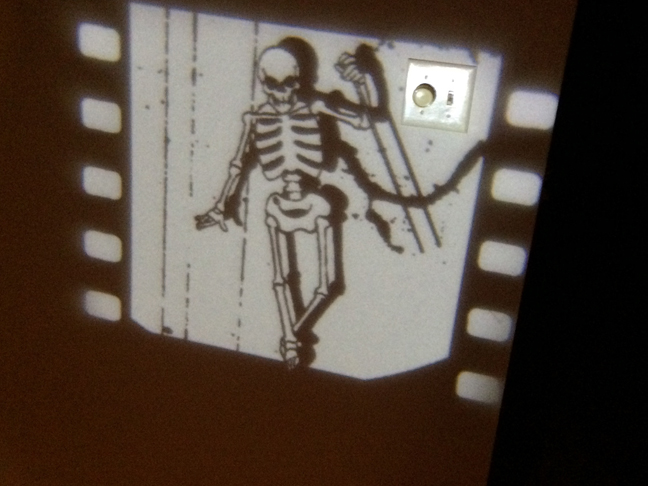
Projected phantom.
|
Last month's October issue contained my review of the Genii convention, a review of Harry Lorayne's (last?) new book, a complete in-home seance, and a farewell to Philip Morris. |
November 2017 Happy Thanksgiving! I'm afraid to count, but did anyway and praise the magic gods for nearly 100 new card tricks and assorted advice played out over four new books from four esteemed authors. And Christmas is still over a month off. Added to this are lessons learned from last month's Halloween seances and photos of and video links to the summer's premiere conventions. And finally, farewell to Fats Domino. He had nothing to do with magic, unless you count an act of generosity from Allan Slaight, but I loved his work. I had the good fortune to see him live on my honeymoon, in Las Vegas, nearly 50 years ago. A very nice weekend. |
|
|
Five books in five weeks! Close on the heels of Harry Lorayne's Jaw Droppers! 2 (reported last month) come four more volumes of innovative card magic, with still more awaiting our attention. It's Thanksgiving season, and we've an excess of riches to be thankful for. To wit ... POST DOC -- The elephant in the room, of course, is that Eugene Burger is no longer with us, and therefore any new material from him, advice in that wonderful professorial voice, is most welcome. Teaching Magic, by Eugene with additional material from Larry Hass, arrives while we are still grieving, and its publication is a welcome surprise. (It is reported that Eugene has two other books in the pipeline, intended to be posthumous, and I look forward to them.)  Still educating. Eugene entered professional magic as a fully formed professor, hence education has always been a given with him. In this new book , he revisits themes that have been part of our student experience ever since Secrets and Mysteries of the Close-up Entertainer. Part One, "Reflections on Teaching and Learning," addresses numerous aspects, among them: Class size at the Magic & Mystery School (small to medium) and in Chicago (individual). The need to sacrifice (only so much time to learn). Larry Hass's seven steps from cradle to stage. Avoid what Jeff McBride calls verbal lint (unnecessary words). (Note: Jeff's The Show Doctor is the best book ever on magical performance.) Imagine difficult audiences when you rehearse. (In the days I used to perform at the Magic Castle, I imagined Carol Roy and Irene Larsen as my helpers.) Try to advise students on what would make them better. Nine considerations for finding new material (most involve practicality). Creating your audience. Part Two, "Essays," draws on stuff Eugene and Larry had published digitally, in Vanish, the MMS Museletter, and Secrets (youth pub for the Magic Circle). The longest is a Q&A session "A Magic Class at Muhlenberg College. Part Three, "Performance Pieces," is likely to be the most popular section with a half dozen items from Eugene and a practical OOTW from Larry. Eugene's offerings include two coin tricks, a bill change that updates his previously published versions, and three strong card tricks. A Strange Coincidence is a Curry-esque effect that might land you in a federal pen. Telephone Magic is a phone-in version of David Solomon's seven-card take on Jim Steinmeyer's nine-card trick (recall that Eugene wrote Solomon's Mind). And my favorite, Not Cutting the Aces, is the stunner that I saw a friend perform in Louisville at the IBM/SAM. The spek cuts to any card, such as a six, and the magi then cuts to find the other three sixes. There are planned deviations along the way and a surprise climax. It was quite exciting to stumble upon this, I'd love to have seen Eugene perform it. Although you can't see this one, you can see him perform his other five, thanks to secret video links from Larry Hass. From his Genii column and other sources, Eugene obviously loved the Q&A format, and Part Four is therefore "Questions," all submitted by his friends (and some of mine) for this book. I hope they enjoy finally seeing his answers as much as the general reader should. Teaching Magic is a 178-page hardback, handsomely and carefully produced (possibly the only book this year for which I didn't spot a typo on first reading) with glowing front and rear matter from Mac King, Larry Hass, and Derren Brown, $39.95 from Theory and Art of Magic Press or your favorite dealer. SATANIC VERSES -- I should spend more time than I do in the J.K. Hartman shelf of my overstocked library. Hartman is by far the most prolific single creator of card tricks to feed my addiction, his hardback works anchored by his seminal 669-page Card Craft and followed by After Craft, Trickery Treats, Card Dupery, CAAN Craft, and Card Dodgery. The latest to weigh in is Card Devilry, with nearly 60 additions to the Hartman oeuvre. (Note: a look back at my review of Card Dodgery, in September 2012, has me twice as excited.) The new book spreads its wealth over five chapters addressing impromptu card magic, mental mysteries, stacks, gaffs, and moves. Of these, I was most intrigued by the stacks chapter. Among other things in it, Hartman offers five widely varied items that rely on a short run (no more than 12 cards) of memorized cards. This is devilishly clever stuff. And everyone thought Card Dodgery was to have been the last Hartman book! 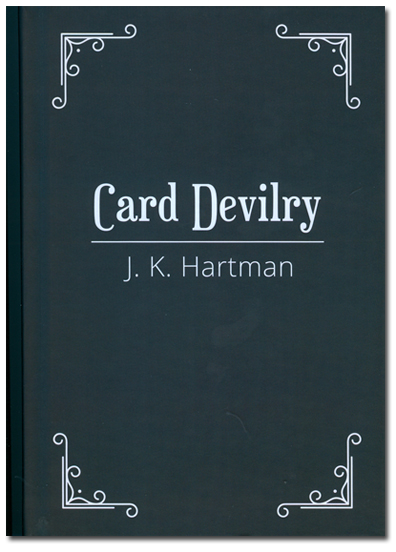 Damned good card tricks. Although I found more items than usual to be beyond my ability (too many passes and half passes, for example), there was plenty of self-working to intermediate material to fascinate. A few in point: X-Rayted is my favorite. Spek thinks of any card named from a shuffled deck, removes the card himself and hides it in the card box, reshuffles the cards, and returns them to the magi. Magi uses his X-ray vision to name the card in the box. Cut Con -- I love bluffs, and this is the boldest I've seen that allows Spectator Cuts to the Aces. To the Pack and Back -- From a packet of ten cards, three known cards are cleanly placed back into the deck. They magically return to the packet. Back into Back into Time -- This is similar to Roy Walton's time machine trick, except that, instead of a single card going back into time, an asymmetrical situation is created with one card in the middle and two on top. All go back in time. CAANdroid -- A computer themed plot for an impromptu ACAAN. Similar to my favorite Hartman trick, Patent Portent. Fish & Pips -- Spek thinks of one of five random cards. With a minimum of fishing, magi names the card. Card Devilry, 292 pp, designed by Andi Gladwin with "a textured matte grey hardboard cover ... embellished with 365 gorgeous illustrations by Tony Dunn," $35 from Vanishing,Inc. GLADIATORS -- I nominate "Gladiators" as the name of the Dan and Dave deck to be supplied with the deluxe edition of Bob Farmer's The Bammo Gaffus Maximus. All gaffs included! If only. The latest tome from Bob Farmer is a 140-page comb bound book in the same format as The Bammo Tarodiction Toolbox. Although it was clear that gaffed cards would play a role in the mysteries, I wasn't sure just how. That is, was it a gaff involving only a few cards, such as a three-card monte routine, or one that gaffed an entire deck, such as the Overcon banked deck found in Tsunami? For most of the tricks, the latter is the answer, full decks prepared thanks to double face cards, double back cards, corner trimmers, marked cards, and so on. If you have the talent and patience for crafts (this takes me back to my earliest days in card magic), you can achieve miracles. 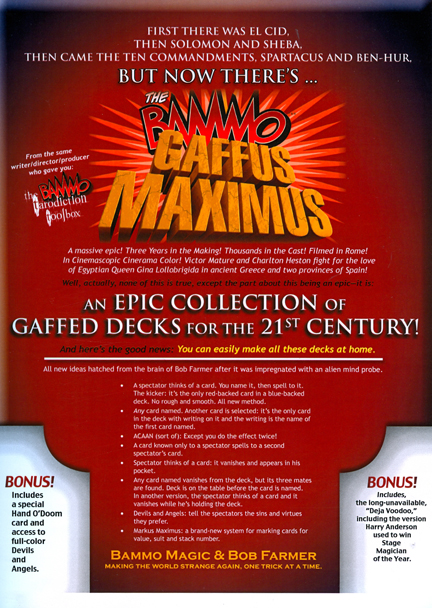 No, I am Spartacus. A few routines that intrigued me: The Magic Red Card of Mystery -- OK, I've never liked that phrasing ("blah blah of Mystery" or "blah blah of Death"), so let's just call a stranger red card a mystery card, and let's have some appropriate text on its back, such as a question mark. Announce in advance that the mystery card will vanish and locate a selected card. Said card is then selected from a blue deck and signed. The red card is placed atop the blue deck from where it vanishes with a wave of your hand (this looks really cool). You find it in the middle of the deck, not next to the signed card, but the red card turns out to be the signed card*. A single gaffed card does all the work. Hand O'Doom -- A Triumph-like routine. About half the cards are in the spek's pocket. Rest of cards are on the table, some face up and some face down. Spek definitely thinks of and sees one of the face up cards. Magi has no idea which it is. The face up cards and face down cards are shuffled. Now the magic: cards are re-spread to show all but one are pointing in the same direction, and the spek's card is missing. Magi looks at the single face down card and divines the spek's selection. But the card is not the selection itself, merely a Hand O'Doom card (special graphic provided). The selection is now in the spek's pocket. Encephalonic Predestination -- Spek deals cards face up and stops anywhere. Suppose it is the 10C. This suggests high clubs, and spek then chooses (simply names) any club from 7 through A. Suppose it is the JC. JC is shown to be the only card with writing on the back, and the writing says 10C. One card has predicted the other. Makes clever use of a 1-0-1 deck and other ruses. Svenvoodoo -- A card is selected, no force, and magi instantly names its value and location. A second card is selected by the same procedure, and the cards are spread across the table. Any number is named, and the selected card is at that location. The selection is not named until it has been counted to.  From my earliest days in card magic. The Bammo Gaffus Maximus, subtitled An Epic Collection of Gaffed Decks, soft cover with one gimmick and a link to full color Devils and Angels routine, 140 pp, $35 USD, email Bob Farmer at bammomagic@cogeco.ca. *Or, you could merely have the mystery card turn up next to the selection, which I argue would be a much better trick. MAGNIFICENT 7 -- This review titles itself, the seventh in the Impuzzibilities series of self-working magic from Jim Steinmeyer. The latest is Unexpected, the initial entry having already been followed by Further, Subsequent, Ensuing, Treacherous, and Devilish. A few thoughts ... 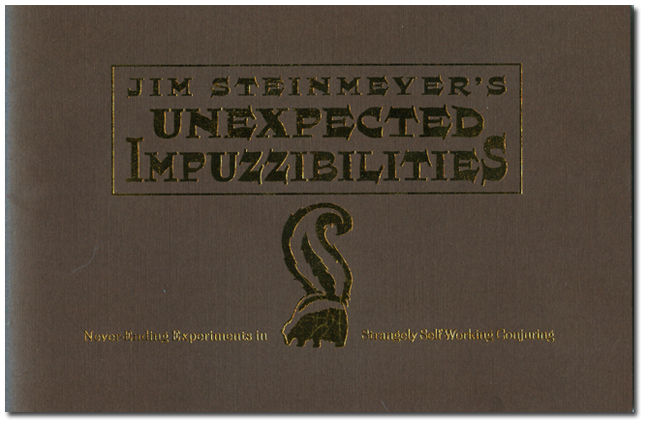 Card tricks I can -- and will -- do. Casting the Spell. One of the delights of working through these little jewels is that you often fool yourself. Such was the case with this guest entry from Robert Ramirez. Spek shuffles half the deck, you shuffle the other half. Really. Each party selects a card, and both cards are lost in the deck. Only now are cards named, say QC and KH. Spell QC, one card per letter, and find KH. Then spell KH and find QC. Brilliant. This may be the cleverest card trick I've come across since Thomas Blomberg's Late Key, the surprising trick I am always looking for when I open a book of card magic. The Poker Face. Spek merely thinks of two cards among six. You divine both. Four-Card Monte. This is a monte you could do over the phone. Spek begins with a queen and three spot cards. Despite her mixing, you locate the queen. Pure Evil. It all happens in the spek's hands. She mixes the cards seemingly fairly and arrives at the only card bearing the word "Evil." Random thought: you could put names on all the cards, a la the Phil trick, and she could arrive at the one card with her hame. The Awful Words Trick. Ah, finally a kid show routine. No, just kidding. Magi shows six cards bearing the sort of words that used to get George Carlin into trouble, or at least they appear to be. The incriminating letters are bleeped out. The patter explains why the words are "bad" but not for the reasons you are thinking of. Until the climax. This is a comedy club-worthy item. * * *
An increase in Magic Castle dues recently riveted my attention. It costs hundreds per year more to be an Associate rather than a Magician member of the AMA. Associates might be wise to invest in a collection of these Steinmeyer self-workers. A reasonably likable chap could put together a most entertaining program of magic and thereby upgrade his status and lower his dues. Unexpected Impuzzibilities, soft cover, 34 pp, to the usual high standard: "the format is elegant, crisp, and clear, with real printing, a gold stamped cover, and protective velum fly sheet." $20 plus postage direct from Jim at jimsteinmeyer.com. |
|
|
SPOOKY OBSERVATION -- I hope that some of you were intrigued by my dinner party seance last month, especially the possibilities inherent in the haunted antique movie projector. It adds a real wow factor. I wound up performing the seance on four occasions around Halloween, three times for home dinner parties and once for a corporate event, and I found the experience most educational. 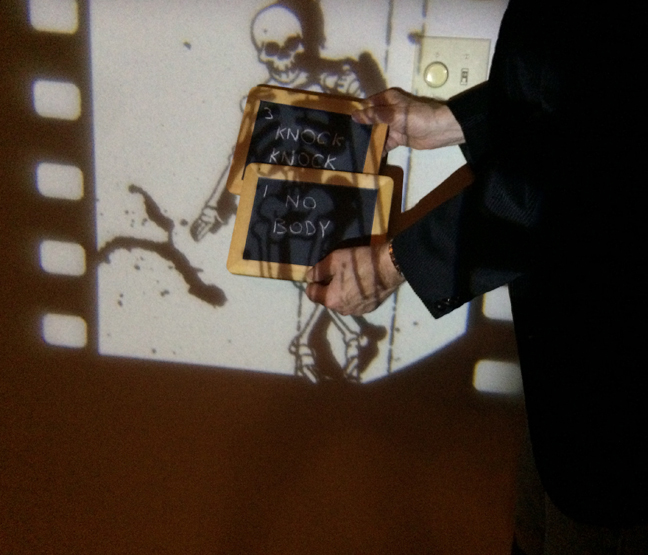 Spirit writing. The seance runs for only five minutes! I've never had the courage to perform such a brief "complete show" before. I had always felt I would be leaving too much out, that the more I did the more I would be appreciated. Just the opposite! Instead, the brevity heightened the impact. (What I did was not diluted, in the spectators' minds, by six or eight additional stunts.) It made it possible to inject the show into the normal flow of affairs (dinner, the work day, etc.) without a lengthy interruption. It made it possible to concentrate on adding spooky touches to the few things I did rather than diluting my own attention with more card tricks. And it made it possible to make the show more about me than about a sequence of routines. All this should have been obvious, but it was the first time I had witnessed the power of that focus in my own work. As Eugene Burger has taught from the get go, and especially about seances, less is more. It just took me most of a century to believe it. CONVENTIONAL VIEWS -- The December issue of Genii contains welcome reviews and copious photos of both the Genii convention and MAGIC Live 2017. I covered the Genii convention last month, at least in black and white, hence am happy to add a few photos in color. 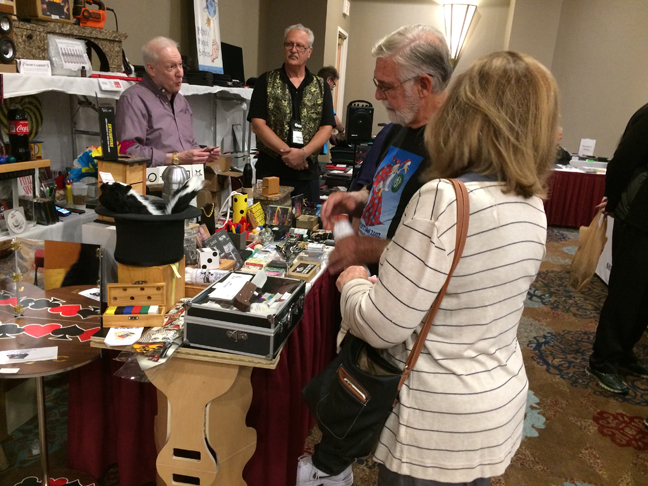 Harry Allen brings the whole store. 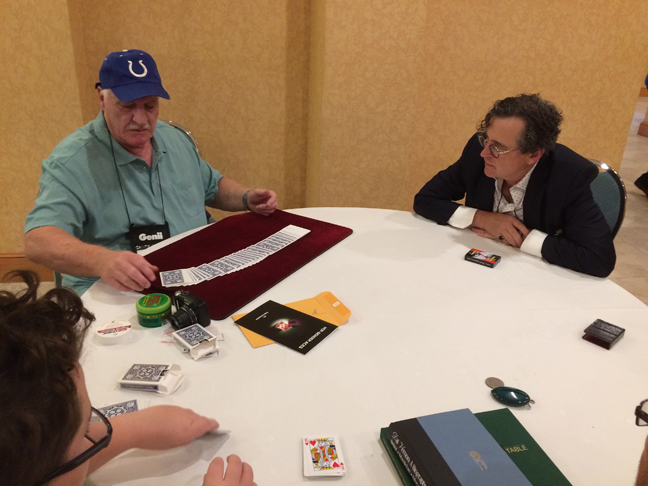 Tom spreads as David studies. 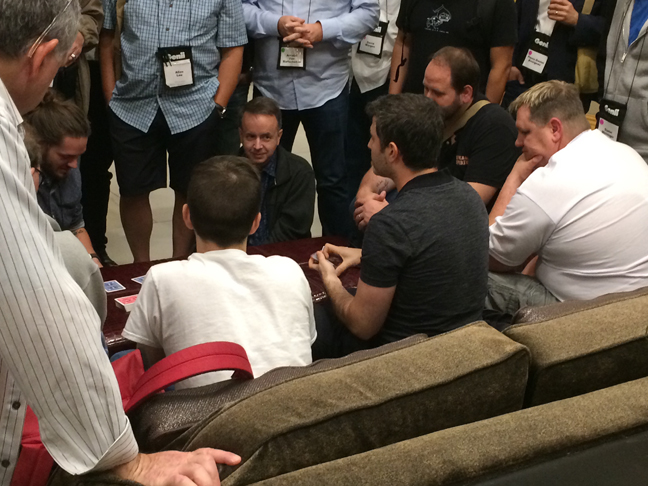 Asi rocks at Genii. I failed to make it to MAGIC Live 2017, but am part of the 70 percent registered so far for the 2018 edition. For those of us so deprived in 2017, Stan has posted videos of two of the sessions, and I hope he posts more. One of the videos is about the accident to and recovery of Abbey Goldrake,injured in an onstage fall. The other is an interview with David Williamson by Julie Eng and Jonathan Levit. I've watched this one multiple times, as David is just so funny, even in real life. There are emotional moments as David describes the sense of community in magic and his evolving role in it. The clip concludes with the appearance of Peanut, the charming life-sized baby elephant puppet from Circus 1903. Check the clips out yourself here. Thanks, Stan. 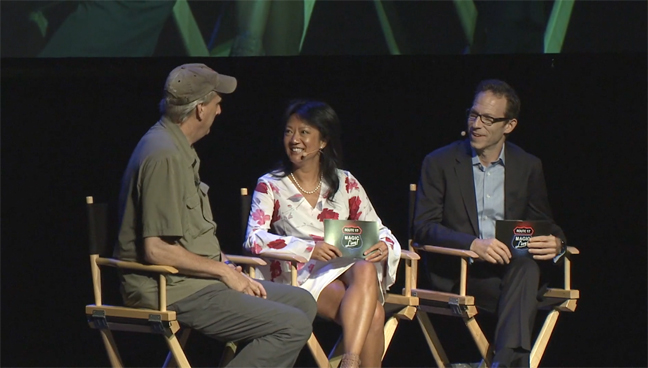 Julie and Jonathan chat with David. |
|
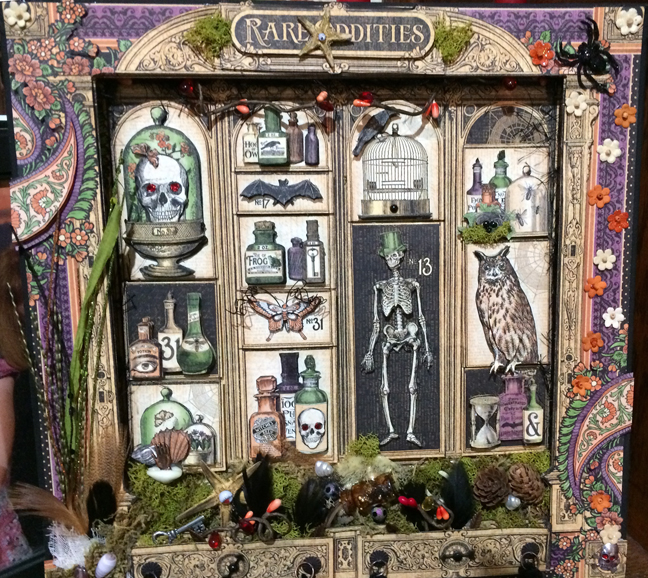 A more colorful view of last month's craft project.
Au revoir, Fats Domino.
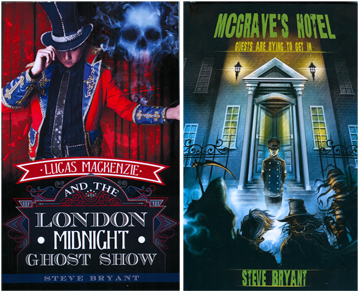
Christmas is coming! Give McGrave's Hotel and Lucas Mackenzie and The London Midnight Ghost Show to good boys and girls. And bad ones.
Little Egypt Magic is the erratically updated web site of Steve Bryant, spawned (the site, not Steve) by a former internet magazine known as The Little Egypt Gazette/for magicians only. Steve Bryant is an obscure magician and writer who generates this site from an iMac in Bloomington, Indiana. He used to frequently journey to and perform magic in Little Egypt, the local name for extreme southern Illinois, where the towns bear such names as Cairo, Thebes, and Karnak. Past issues of this web site: Index to Past Issues Notice: Any limited use of copyrighted images or quoted text is considered fair use, usually to review whatever product or event that is under discussion. If you object to use of any material, please get in touch and it will be cheerfully removed. |
A JSB Creations product
Copyright© 2017 by Steve Bryant